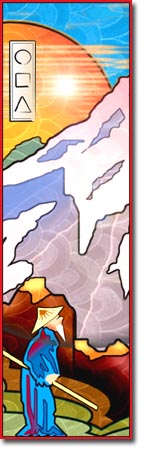On The Way: The Daily Zen Journal
The Platform Sutra
Daijian Huineng (638–713)
The samadhi of oneness is straightforward mind at all times, walking, staying, sitting, and lying.
“Straight-forward mind is the place of practice; straight-forward mind is the Pure Land.”
Only practice straight-forward mind, and in all things have no attachments whatsoever; this is called the samadhi of oneness. The deluded person clings to the characteristics of things, adheres to the samadhi of oneness, thinks that straightforward mind is sitting without moving and casting aside delusions without letting things arise in the mind.
This he, or she, considers to be the samadhi of oneness. This kind of practice is the same as insentiency and the cause of obstruction to the Tao. Tao must be something that circulates freely; why should we impede it? If the mind does not abide in things, the Tao circulates freely; if the mind abides in things, it becomes entangled. If sitting in meditation without moving is good, why did Vimalakirti scold Shariputra for sitting in meditation in the forest?
Good friends, some teach people to sit viewing the mind and viewing purity, not moving and not activating the mind, and to this they devote their efforts. Deluded people do not realize that this is wrong, cling to this doctrine, and become confused. There are many such people. Those who instruct in this way are, from the outset, greatly mistaken.
How then are meditation and wisdom alike? They are like the lamp and the light it gives forth. If there is a lamp, there is light; if there is no lamp, there is no light. The lamp is the substance of light; the light is the function of the lamp. Thus, although they have two names, in substance they are not two. Meditation and wisdom are also like this.
In the Dharma there is no sudden or gradual, but among people some are keen and others dull. The deluded recommend the gradual method, the enlightened practice the sudden teaching. To understand the original mind for yourself is to see into your own original nature. Once enlightened, there is from the outset no distinction between these two methods; those who are not enlightened will for long kalpas be caught in the cycle of transmigration.
In this teaching of mine, from ancient times up to the present, all have set up no-thought as the main doctrine, non-form as the substance, and non-abiding as the basis. Non-form is to be separated from form even when associated with form. No-thought is not to think even when involved in thought. Non-abiding is the original nature of man.
Successive thoughts do not stop; prior thoughts, present thoughts, and future thoughts follow one after the other without cessation. If one instant of thought is cut off, the Dharma body separates from the physical body, and in the midst of successive thoughts there will be no place for attachment to anything. If one instant of thought clings, then successive thoughts cling; this is known as being fettered. Therefore, non-abiding is made the basis.
Being outwardly separated from all forms, this is non-form. When you are separated from form, the substance of your nature is pure. Therefore, non-form is made the substance.
To be unstained in all environments is called no-thought. If on the basis of your own thoughts you separate from environment, then, in regard to things, thoughts are not produced. If you stop thinking of the myriad things, and cast aside all thoughts, as soon as one instant of thought is cut off, you will be reborn in another realm.
Students, take care! Don’t rest in objective things and the subjective mind. If you do so, it will be bad enough that you yourself are in error, yet how much worse that you encourage others in their mistakes?
The deluded person, however, does not see and slanders the teachings of the sutras. Therefore, no-thought is established as a doctrine. Because people in their delusion have thoughts in relation to their environment, heterodox ideas stemming from theses thoughts arise, and passions and false views are produced from them. Therefore this teaching has established no-thought as a doctrine.
People of the world, separate yourselves from views; do not activate thoughts. If there were no thinking, then no-thought would have no place to exist. “No” is the “no” of what? “Thought” means “thinking” of what? “No” is the  separation from the dualism that produces the passions. “Thought” means thinking of the original nature of True Reality.
separation from the dualism that produces the passions. “Thought” means thinking of the original nature of True Reality.
True Reality is the substance of thoughts; thoughts are the function of True Reality. If you give rise to thoughts from your self-nature, then, although you see, hear, perceive, and, know, you are not stained by the manifold environments, and are always free. The Vimalakirti Sutra says:
“Externally, while distinguishing well all the forms of the various dharmas, internally stand firm within the First Principle.”
In this teaching from the outset sitting in meditation does not concern the mind nor does it concern purity; we do not talk of steadfastness. If someone speaks of “viewing the mind,” then I would say that the “mind” is of itself delusion, and as delusions are just like fantasies, there is nothing to be seen.
If someone speaks of “viewing purity,” then I would say that human nature is of itself pure, but because of false thoughts True Reality is obscured. If you exclude delusions, then the original nature reveals its purity.
If you activate your mind to view purity without realizing that your own nature is originally pure, delusions of purity will be produced. Since this delusion has no place to exist, then you know that whatever you see is nothing but delusion.
Purity has no form, but, nonetheless, some people try to postulate the form of purity and consider this to be Chan practice. People who hold this view obstruct their own original natures and end up being bound by purity. One who practices steadfastness does not see the faults of people everywhere. This is the steadfastness of self-nature.
The deluded person, however, even if he doesn’t move his own body, will talk of the good and bad of others the moment he opens his mouth, and thus, behave in opposition to the Tao. Therefore, both “viewing the mind” and “viewing purity” will cause an obstruction to Tao.
Now that we know that this is so, what is it in this teaching that we call “sitting in meditation”? In this teaching “sitting” means without any obstructions anywhere, outwardly and under all circumstances, not to activate thoughts. “Meditation” is internally to see the original nature and not become confused.
And what do we call Chan meditation? Outwardly to exclude form is Chan; inwardly to be unconfused is meditation. Even though there is form on the outside, when internally the nature is not confused, then, from the outset, you are of yourself pure and of yourself in meditation.
The very contact with circumstances itself causes confusion. Separation from form on the outside is Chan; being untouched on the inside is meditation. Being Chan externally and meditation internally, is known as Chan meditation.
The Vimalakirti Sutra says:
“At once, suddenly, you regain the original mind.” The P’u-sa-chieh says: “From the outset your own nature is pure.”
See for yourselves the purity of your own natures, practice and accomplish for yourselves. Your own nature is the Dharmakaya, and self-practice is the practice of Buddha; by self-accomplishment you may achieve the Buddha Way for yourselves.
Daijian Huineng (638–713)
Excerpted from The Platform Sutra of the Sixth Patriarch, translated by Philip Yampolsky 1967




Many of us are familiar with the first part of the Platform Sutra recounting the story of Huineng’s life and how he obtained the robe and bowl after arriving at the monastery as a commoner. Legend has it that as a child while selling firewood, he just happened to hear a man reciting the Diamond Sutra and awakened to its meaning. . At that point he asked the man where he came from and determined to go there to study with the Fifth Patriarch, Hung-jen.
This second part of the Platform Sutra is where our piece begins, a profound lecture on prajna. He prepares his listeners at the very beginning with an introduction that even today we can use to help prepare ourselves to listen and receive a teaching.
“My teaching has been handed down from the sages of the past; it is not my own personal knowledge. If you wish to hear the teachings of the sages of the past, each of you must quiet his mind and hear me to the end. Please cast aside your own delusions; then you will be no different from the sages of the past.”
Hui-neng
While there are some very deep principles in this selection, there is also the heart of simplicity helping us to cut through the sidepaths we sometimes wander down. The depth of the reading almost overwhelms us and beckons us return for new insights. However, there is an ultimate confidence communicated that shifts us closer to true understanding rather than getting caught up in stages and levels.
“See for yourselves the purity of your own natures, practice and accomplish for yourselves. Your own nature is the Dharmakaya, and self-practice is the practice of Buddha; by self-accomplishment you may achieve the Buddha Way for yourselves.”
Steadfastly,
Elana